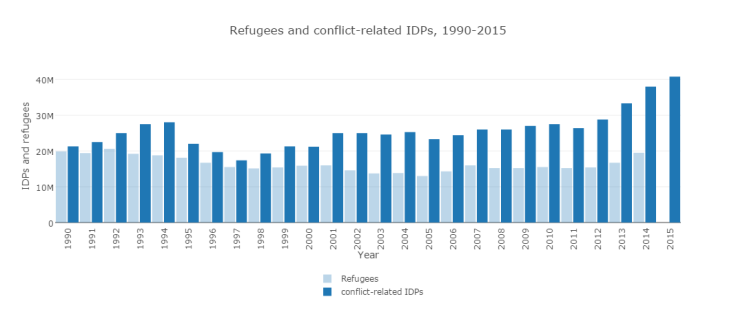Conflicts, Disasters Displaced Nearly 28 Million People Worldwide In 2015, Report Shows

The stories of the hundreds of thousands of refugees, migrants and asylum-seekers, who have risked their lives to reach European shores in search of a safe haven, have drawn much attention to the phenomenon of displacement; but they represent only a fraction of a more complex issue, according to a new report, which highlights the global crisis of internal displacement.
Conflict, violence and disasters internally displaced 27.8 million people in 2015, taking the total number of internally displaced people (IDPs) last year to a record 40.8 million, the report released Wednesday by the Geneva-based Internal Displacement Monitoring Centre (IDMC), said.
“There are now twice as many internally displaced people as refugees worldwide,” Jan Egeland, head of the Norwegian Refugee Council (NRC), said in a statement. “IDPs often lose everything when they flee, and the trauma and upheaval of displacement leave many with deep psychological and physical scars.”
Some 8.6 million IDPs in 2015 — an average of 24,000 a day — were linked to conflict, including 4.8 million in the Middle East and North Africa. Other nations with the highest number of people fleeing were Ukraine, Nigeria, Democratic Republic of the Congo, Afghanistan, Colombia, Central African Republic and South Sudan.

The report also said that disasters displaced about 19.2 million people across 113 countries in 2015, more than twice the number who fled conflict and violence during the same year. India, China and Nepal had the highest numbers, with 3.7 million, 3.6 million and 2.6 million, respectively.
“Displacement in the Middle East and north Africa has snowballed since the wave of social uprisings known as the Arab Spring in late 2010 and the rise of the Islamic State [group],” with Yemen, Syria and Iraq accounting for more than half of the global total, the report said.
The total number of new displacements last year “is the equivalent of the combined populations of New York City, London, Paris and Cairo grabbing what they can carry, often in a state of panic, and setting out on a journey filled with uncertainty,” Egeland said. “Put another way, around 66,000 people abandoned their homes every day of 2015.”
The report also measured the number of people displaced by criminal violence associated with drug trafficking and gang activity, displacing at least a million people in El Salvador, Guatemala, Honduras and Mexico as of December 2015.
“Studies have established a direct link between criminal violence and migration, but such displacement in the region tends to remain unquantified and unaddressed for reasons ranging from political to methodological,” the report said.
© Copyright IBTimes 2025. All rights reserved.






















